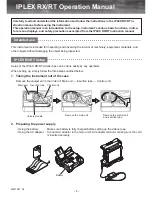
Command reference
R&S
®
ZNL/ZNLE
635
User Manual 1178.5966.02 ─ 19
Related common commands
The STB is read out using the command
*STB?
or a
The SRE can be set using command
*SRE
and read using
*SRE?
.
IST flag and PPE
(SRQ), the Individual STatus (IST) flag combines the
entire status information in a single bit. It can be queried by a
.
The Parallel Poll Enable (PPE) register determines which bits of the STB contribute to
the IST flag. The bits of the STB are ANDed with the corresponding bits of the PPE,
with bit 6 being used as well in contrast to the SRE. The IST flag results from ORing all
results.
Related common commands
The IST flag is queried using the common command
*IST?
. The PPE can be set
using
*PRE
and read using
*PRE?
.
See also
ESR and ESE
The Event Status Register (ESR) indicates general instrument states. It is linked to the
Event Status Enable (ESE) register on a bit-by-bit basis.
●
The ESR corresponds to the CONDition part of a SCPI register indicating the cur-
rent instrument state (although reading is destructive).
●
The ESE corresponds to the ENABle part of a SCPI register. If a bit is set in the
ESE and the associated bit in the ESR changes from 0 to 1, the ESB bit in the STa-
tus Byte (STB) is set.
The bits in the ESR are defined as follows:
Bit No.
Meaning
0
Operation complete
This bit is set on receipt of the command *OPC after all previous commands have been
executed.
2
Query error
This bit is set if either the controller wants to read data from the instrument without having
sent a query, or if it does not fetch requested data and sends new instructions to the instru-
ment instead. The cause is often a query which is faulty and hence cannot be executed.
3
Device-dependent error
This bit is set if a device-dependent error occurs. An error message with a number
between
–
300 and
–
399 or a positive error number, which describes the error in greater
detail, is entered into the error queue. See also
Chapter 12.1, "Error messages and trou-
4
Execution error
This bit is set if a received command is syntactically correct, but cannot be performed for
other reasons. An error message with a number between
–
200 and
–
300, which describes
the error in greater detail, is entered into the error queue.
VNA remote control basics
















































